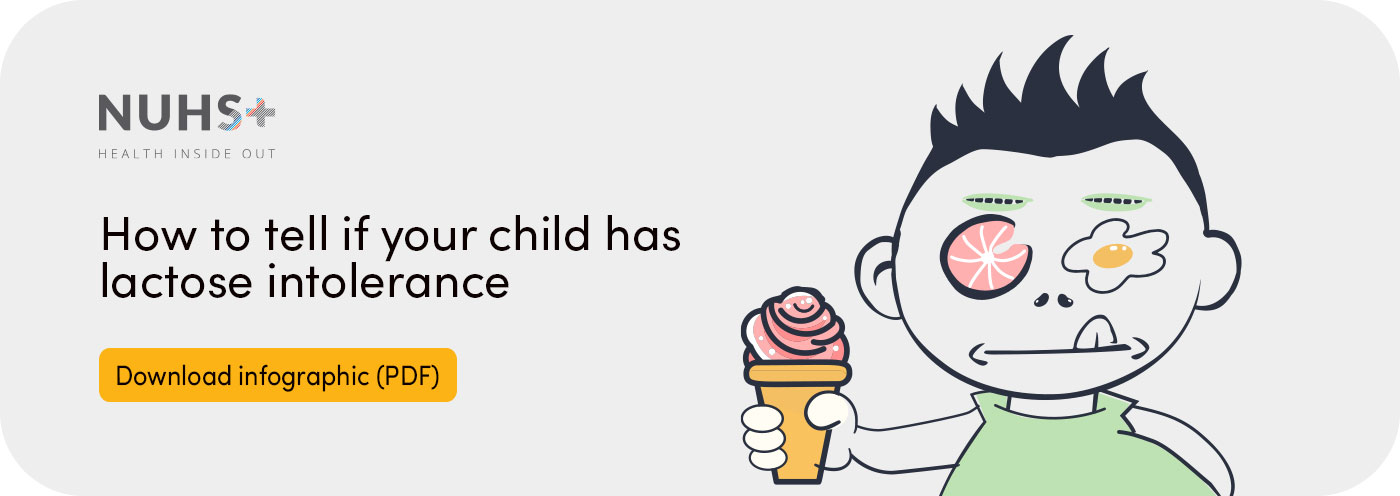Published on 21 March 2024
Recognise the signs of lactose intolerance in your child, and know the differences between allergies and irritable bowel syndrome.
Does eating ice-cream or dairy products cause your child painful stomach cramps and urgent trips to the toilet? Your child could be suffering from lactose intolerance, a digestive disorder that occurs when the body does not have enough lactase enzyme.
Lactase enzyme helps to digest lactose, a sugar found in milk and dairy products. Undigested lactose in the gut can lead to excessive gas production, bloating, diarrhoea and abdominal cramps.
“Asians are more predisposed to lactose intolerance than Caucasians, due to our genetic makeup since lactase — the enzyme that breaks down lactose in the small intestine — is produced by genes,” said Dr James Huang, Consultant, Division of Paediatric Gastroenterology, Nutrition, Hepatology and Liver Transplantation, Department of Paediatrics, Khoo Teck Puat – National University Children’s Medical Institute (KTP-NUCMI), National University Hospital (NUH).
“Most individuals with the condition are otherwise healthy, without any additional medical concerns. Their gastrointestinal system is typically normal,” he added.
Although most infants are born with lactase, children may begin to exhibit lactose intolerance as young as four years old, and the severity of the condition tends to increase with age.
Types of lactose intolerance
|
Identifying signs of lactose intolerance in your childA thorough medical history and physical examination, including details about your child's diet, can help diagnose primary lactose intolerance and rule out other health concerns. Objective tests like hydrogen breath testing might not be needed if the diagnosis is clear. Additional tests such as blood tests or endoscopy may be necessary if secondary lactose intolerance is suspected. Although there's no cure for primary lactose intolerance in children due to genetic factors, effective management strategies can help alleviate symptoms and improve your child's quality of life. |
Helping your child navigate primary lactose intolerance
|
In distinguishing primary lactose intolerance from other conditions, it's important to note that cow’s milk is a major source of lactose for children. Often, primary lactose intolerance is mistaken for cow’s milk allergy.
Cow’s milk allergy is among the most prevalent food allergies, typically affecting young infants exposed to cow’s milk within their first six months. Some symptoms of a food allergy can resemble those of primary lactose intolerance.
Another condition that might be confused for primary lactose intolerance is irritable bowel syndrome (IBS). While both could present symptoms like bloating or diarrhoea, IBS also includes digestive issues like constipation and can occur due to various factors not limited to diet.
Dr Huang highlights that primary lactose intolerance poses no risk to physical health, though secondary lactose intolerance can signal a serious underlying medical condition of the gut that should be treated.
So, when should you take your child to see a doctor about their condition?
“The simplest way is for parents to ask themselves if the child's overall physical health, including their growth (height and weight), is impacted? Are their well-being indicators, such as appetite and energy levels, affected? While primary lactose intolerance generally doesn't impact a child's physical health, if you observe any changes, it's important to seek prompt treatment as there may be an underlying serious cause,” advised Dr Huang.
In consultation with Dr James Huang, Consultant, Division of Paediatric Gastroenterology, Nutrition, Hepatology and Liver Transplantation, Department of Paediatrics, KTP-NUCMI, NUH.


